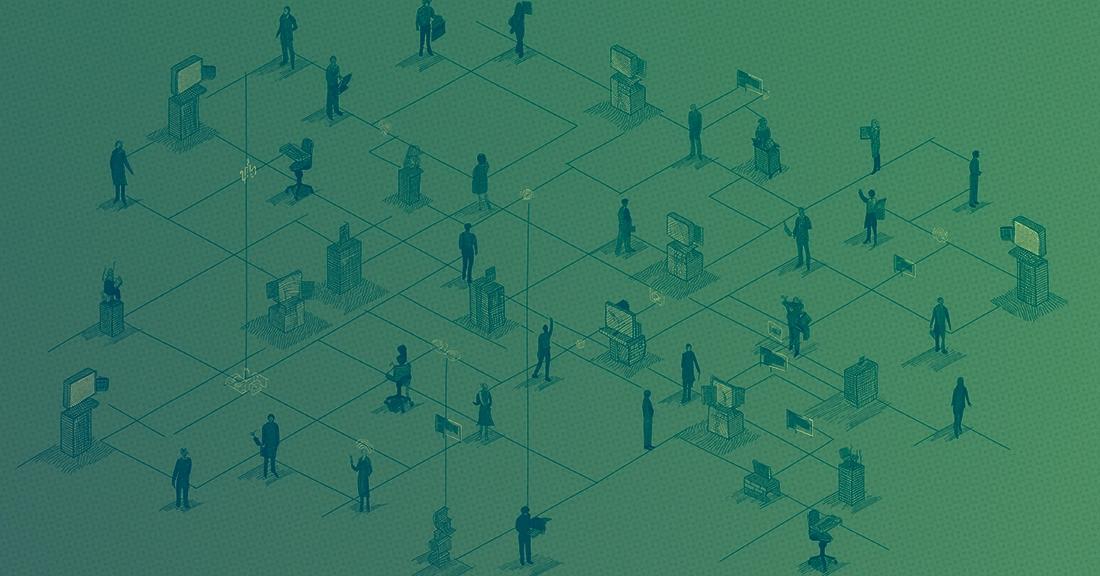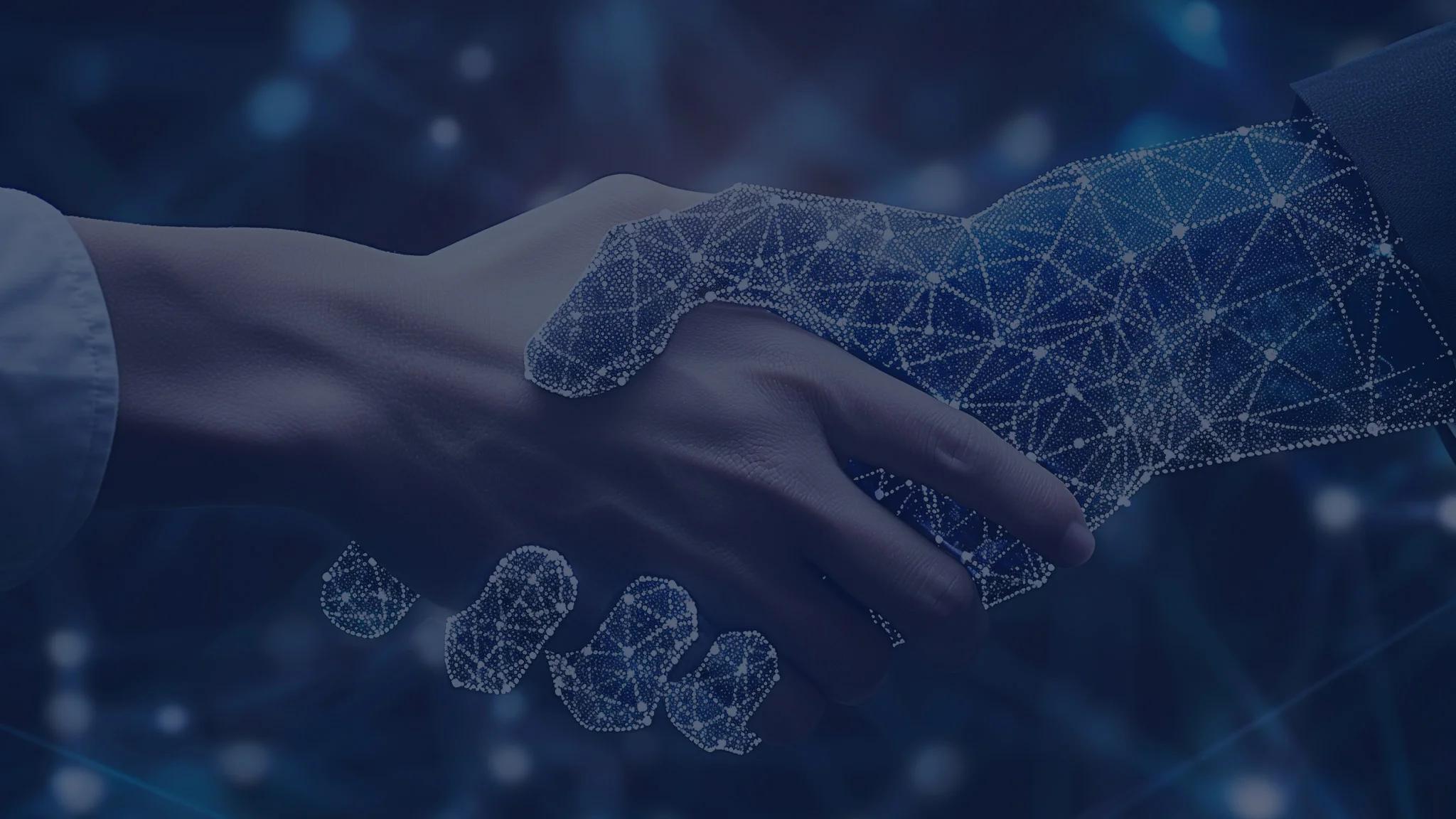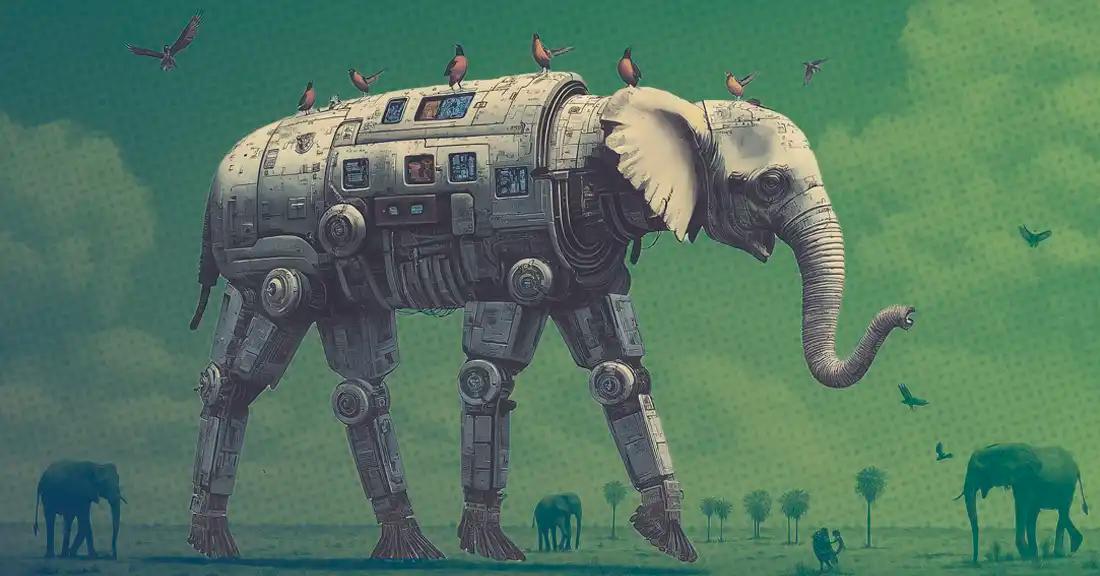

When generative AI first gained mainstream traction, people were surprised at how “human” it felt. AI didn’t just automate rote tasks, it wrote poetry about your dog, or drew a picture of a llama playing basketball. It was a toy. And then it wasn’t. It was something more…
The software exhibited a degree of humanness – a quality that is vastly underestimated in both founder and investor circles.
AI isn’t just amazing because it’s smart and efficient – it’s amazing because it can make humans feel things. It can scare us, make us uncomfortable, but also delight and inspire us.
There has, perhaps, never been a technology as good at simulating genuine interactions as generative AI. And it’s only getting better.
Because of this, and recent developments in the AI stack, we believe we’re heading toward a new paradigm for AI, and computing in general. We call it “Software with a Soul.”
Software with a Soul (SwaS) are products where “humanness” is the core value proposition. It’s delightful, intuitive, empathic, helpful, but also stochastic if it needs to be. AI is allowing us to productize and deliver the true experience of “humanness” at scale – machines that interact with us (and the world around them) with the same attributes we would expect from real human beings.
We are going to see scalable, multi-directional human-computer interactions, which allows these products to tap into new markets.
What is Software with a Soul?
Software with a Soul is artificial intelligence that is capable of “humanness” – we define that as stochastic creativity, empathy, intuition, ability for connection and even emotional expression. It’s computer interaction the way our brains are originally programmed – to interact with other beings. We treat these systems as other beings, rather than productivity tools (e.g. traditional SaaS).
In other, more interesting cases, we see these software products as expansions of ourselves.
In some ways, we’ve been traveling this path for decades. Our innate reaction to novel technology is, often, to treat it like a real person. (For more on this, you can check out a theory described in 2000 “Computers Are Social Actors”).
But over time, and with more familiarity, that novelty wears off. Today, few see their SaaS software as a co-worker (though, with AI workers, this paradigm is likely to change).
AI is traveling this path too. There are countless examples of people asking ChatGPT nicely to do work, or thanking an AI avatar for their input. Some of that certainly comes down to novelty effects. But AI is the first technology we’ve ever had that’s capable of actually acting like a human in return.
What does that tell us? We predict there’s going to be a split in the AI ecosystem. Not all jobs need “humanness” to be done well. But many will be enhanced by it. There will be an emergence of a class of AI for which humanness is the core value proposition.
Here is the breakdown we’re likely to see:
1. Anonymous Automation
AI tools that remain focused on efficiency, and rote automation, will likely stop being viewed as social beings. The work product is the core value proposition, so humanness isn’t necessary, and it’s not missed when it’s not there
Algorithmic matching is an early example of this, but we could imagine “AI agents” for example that don’t need to have names and job descriptions: they just do the work and get out of the way. Those forms of AI, while valuable, will be like an invisible, omnipresent hand.
2. “Humanness” is the last mile
These software products are largely “anonymous” automation, but feature humanness as an added delight.
For example, the bulk of the sales lead identification process is done in the background, but the outreach email is written by a personable, “humanesque” AI.
This is also likely to be the end outcome for many AI voice agents. For most customer service requests, you will want deterministic outputs from an AI. But hearing a kinder, more patient voice over the phone radically changes the experience of that service.
Certain AI workforce agents may also perform better if they’re able to understand social dynamics in the workplace, and respond appropriately. Depending on your field, that understanding could be essential for PMF.
3. Humanness is the product. (Software with a Soul)
The entire purpose of this software is to feel and act like a human. They’re unpredictable, empathetic, caring, intuitive. Even funny. For SwaS, “humanness” is the core value proposition – not a side effect.
Using these buckets, you could map this developing space on two axes. AI will deliver an output that’s either deterministic or stochastic, and will exhibit some degree of emotional intelligence along the way.
Some tasks need to be both stochastic and highly emotional intelligent AI: i.e. synthetic users that need to behave like real human beings to get a clear sense of how people will truly use an interface.
Some tasks require slightly more determinism, but emotional intelligence is key in the delivery: i.e. a customer service call where protocols need to be followed, but the experience is enhanced by injecting a little empathy into the process.
If you start to think about SwaS companies on these two planes, you start to see where everyone falls into line:
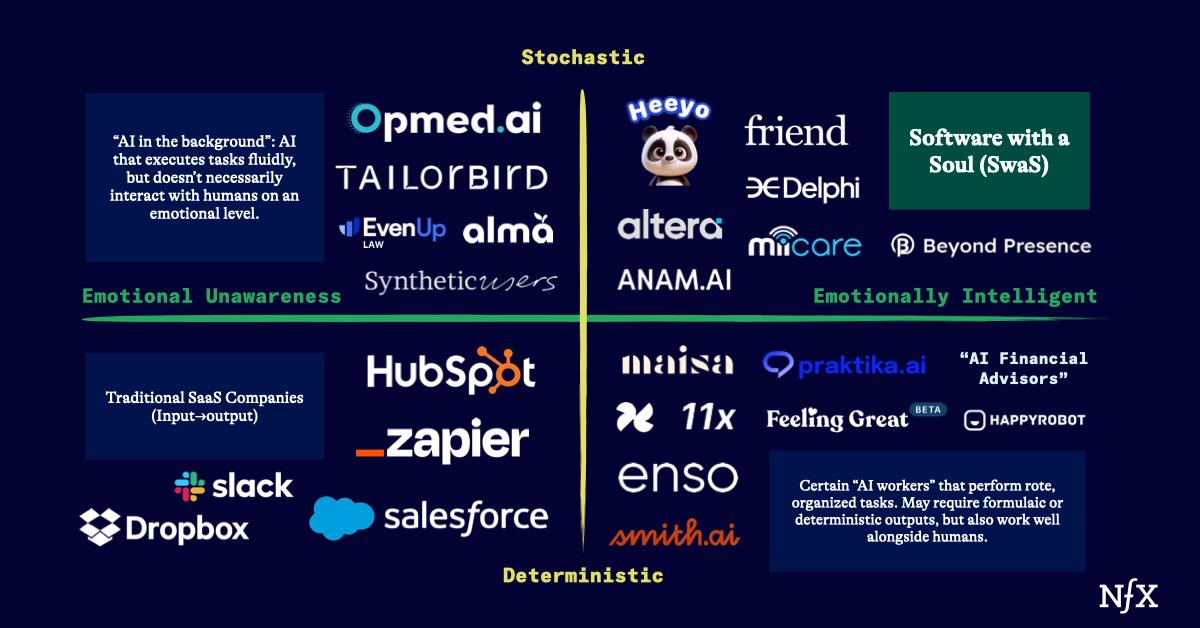

We know that we’re not seeing every potential avenue here yet. This space is extremely early, but we are tracking its development closely. Please let us know what we’re missing
The Opportunity: Scaling Humanity
AI is driving the marginal cost of humanness to zero.
It’s the same pattern that has caused major economic dislocations in the past. In the 1990s, chips drove the marginal cost of computing to zero and we got IBM. The internet drove the marginal cost of distribution down to zero, and gave us Google, Facebook, and Netflix.
Software with a Soul is, for the first time, allowing us to scale up the “softer” more social parts of human interactions. It’s suddenly possible to program, price and distribute “humanness” like bits, rather than atoms.
Shifts like this often open new markets. We expect Software with a Soul to resonate with customers anywhere the supply of humanness is scarce.
Some examples:
- Fields with need for 24/7 empathy + understanding (therapy, education, nursing, hospice care)
- Personalized luxury or premium services (personal shoppers, guided life/fitness coaching, etc)
- Digital cloning and new forms of identity (imagine being able to send a digital clone to attend a meeting, do administrative tasks, or make extra money renting your domain expertise on a marketplace)
- Synthetic personas for all types of market research and simulations – Simulated human behavior to test products and gather feedback, without having to recruit, schedule, and interview humans.
- Synthetic humans for entertainment and/ or companionship
- RPGs and Gaming – gamers are used to playing against NPCs or computers. Software with a Soul will be necessary to play alongside actors that feel really fun – they act random, make jokes, provide a social element to gaming that already exists human-to-human but could scale infinitely with this technology.
- Personal relationships – AI boyfriends and girlfriends
- Enhancing our own humanity or abilities – giving us superpowers, like making everyone a musician, a filmmaker, fluent in every language…
The SwaS Tech Stack
We think of the classic LLM as the “brain” of most SwaS companies. But the stack goes far beyond that. Taken together, we’re developing technology that can replicate many of the experiences of humanness – voices that sound like us, face models that interact with us, even hardware like headsets or robotics that make the bridge between AI and the physical world.
We imagine a full-stack SwaS company would look something like this:
The Brain: i.e. LLMs and other forms of AI that grasp the inherent complexity of human interaction. We don’t always say what we mean, for instance, or don’t know how to articulate our ideas perfectly. Skilled SwaS will see through our obfuscations, even when we don’t.
The Visual Experience: products that develop experiences more akin to normal social interactions. We don’t think that SwaS has to look like an AI avatar. It doesn’t even have to look like a person. But, there do need to be certain social inputs, like non-verbal communication, that make these interactions feel more genuine.
For example, it’s far more natural for people to speak their thoughts than to write them (writing is a learned process). SwaS with voice-based input needs to sound like a person, filler words and all and react to your particular quirks.
The Bridge to the Physical World (i.e. hardware). In the interim, hardware like VR headsets will help humans better interact with SwaS. These act as portals to bring us into the digital world, enhancing our experience of these software beings.
But in the long term, AI will have to meet us where we actually are: the real world.
Eventually, we’re going to see a version of embodied AI – a robot that captures the physical experience of interacting with a human. If you follow the trajectory of SwaS to the end, it’s very clear we are going to need agents that are capable of learning and interacting with physical environments.
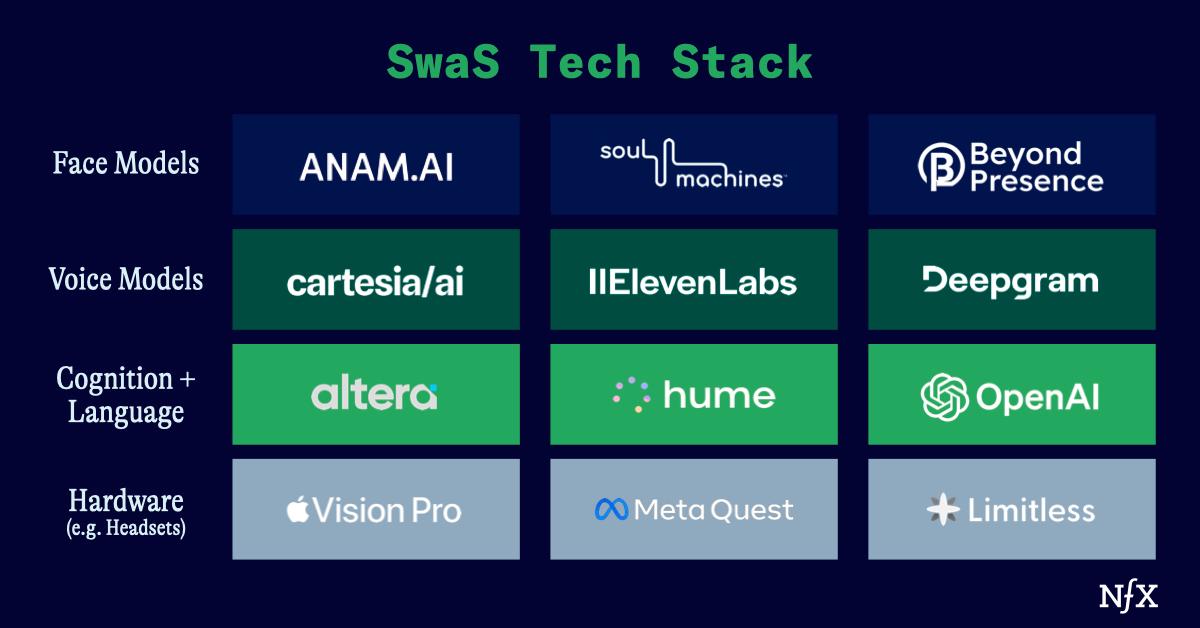

Digital Cloning: An Early Example of SWaS
We’ve previously discussed the idea that AI is creating a fusion between software and labor.
This is going to be a spectrum. Some software will have heavier labor components than others. Those on the most experimental end of the spectrum will look more like workers than software…that’s where we find AI workers, and increasingly, AI clones of actual humans.
The idea of a digital clone is one of the first use cases where we see SwaS distinguish itself. Digital clones are distinctly different from general knowledge engines. Instead, they’re a scaled up version of a specific person’s point of view, approach, communication style or life experience.
There are tasks that require your attention, presence and engagement and for which no one can really substitute you. Now you will be able to perfectly delegate. You can both save time (sending your clone to do x you don’t want to do) and also increase your impact.
For example, a life coach might have a tier that gets an AI clone, and a tier that gets the real person. Or an influencer can now license their clone to attend an interview or a shoot. We may even see digital clones of loved ones after they pass away.
The same way that businesses are able to scale up revenue with AI workers, individuals will scale themselves using digital clones.
So far, we’re already seeing this take shape with companies like Anam, Beyond Presence or Delphi.ai. But this is especially fast moving water, and far more companies will follow in this vein.
The Hard Question: Does This Mean We’re Not Special Anymore?
Humans are incredibly special, creative, and caring. But the problem is that our best attributes just don’t scale.
Empathy, kindness, time – these things are priceless and limited. Even people who make these attributes their careers are especially prone to burnout and overwork (during COVID, nurses, contact tracers and doctors were especially susceptible to “compassion fatigue” – a form of burnout and emotional depletion that happens through the continuous giving of self).
Software with a Soul is providing us with the ability to finally scale up humanity’s good traits. It will enable more people to have better, more fulfilling experiences and connections.
What if your therapist answered calls 24/7, had perfect memory and knew to be especially present during your triggers or low moments? What if you could hire a life coach that could be with you all the time, helping you achieve your goals and make better choices? (Side note: this concept is described really elegantly in the short story Better Living Through Algorithms by Naomi Kritzer) What if you had a bot that could handle the logistics of the bereavement process, and counseled you through each step?
We can all agree that if there were infinite humans in the world who could fill those gaps, that would be ideal. But that’s not reality.
This is going to be a process.We are dealing with dearly-held beliefs about what being human really is. Startups need to prove that they have both the technology and the emotional IQ needed to bring this technology to market in a way that people embrace, rather than reject.
This technology has huge potential, but it has to be wielded carefully and responsibly.


Social Animals Need Social Machines
We are wired to express our ideas socially, to other beings. When we do that, it feels right. We feel seen, heard, cared about. It’s the way we’re built.
Until now, we’ve only been able to do that with other humans. This is the first time, perhaps in the history of our planet, where we are developing a viable other option: another being capable of interacting with us and triggering those feelings of belonging.
If we can create software that we perceive and treat as a being, it will form the platform for a huge variety of things we can’t even imagine.
And we get to be here, at the very beginning.
Special thanks to Alice Liu, Caoimhe Murphy, Awais Shafique, Nico Christie, Sasha Kaletsky for their thoughts and feedback on this essay.
As Founders ourselves, we respect your time. That’s why we built BriefLink, a new software tool that minimizes the upfront time of getting the VC meeting. Simply tell us about your company in 9 easy questions, and you’ll hear from us if it’s a fit.

